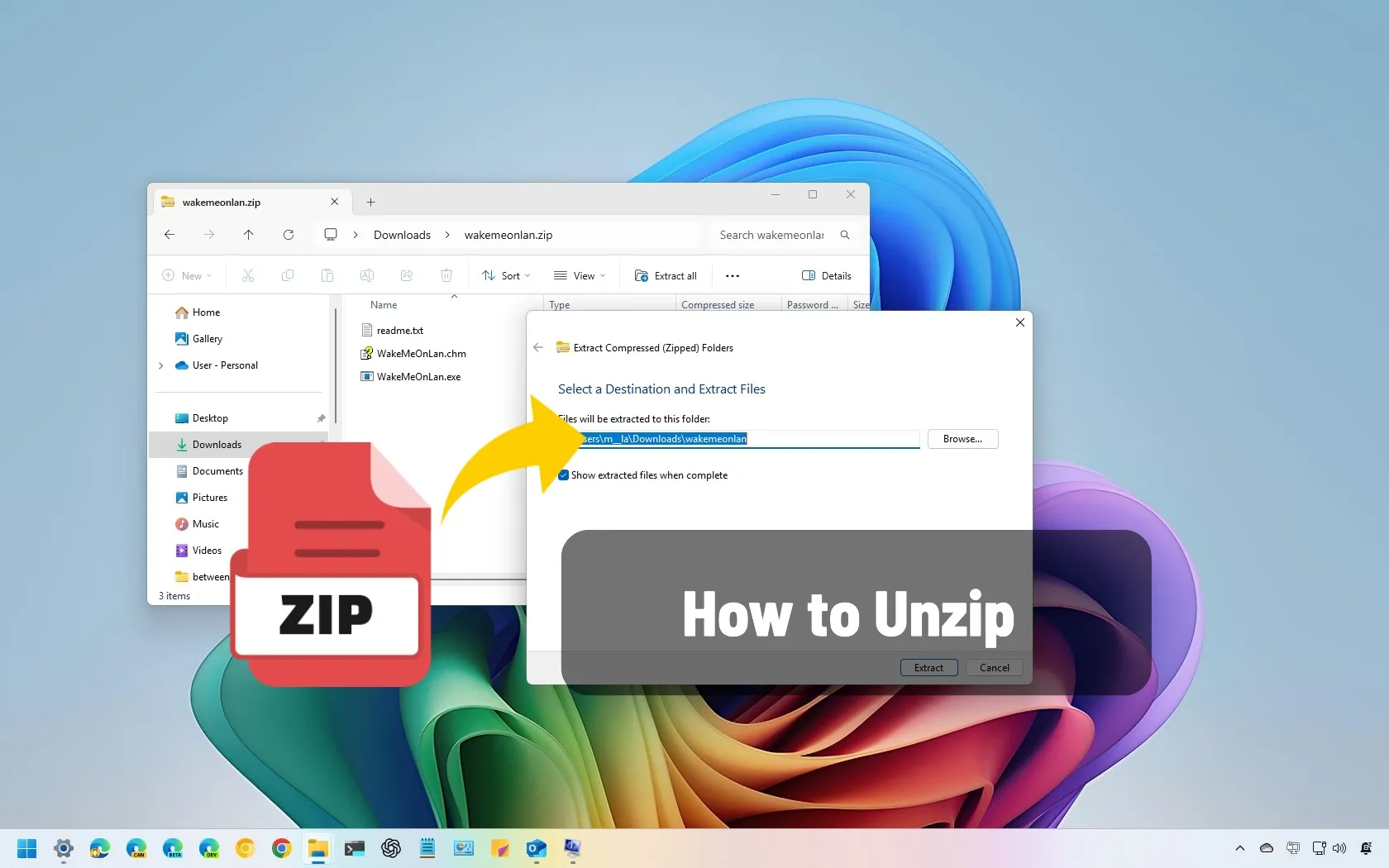How to unzip files on Windows 11, 10

- To unzip files on Windows 11, open the zipped folder on File Explorer, click “Extract all,” select the destination, and click “Extract.”
- You can also select a file from the zipped file, copy and paste it, or drag it to the new location to extract a single file.
- Alternatively, you can open PowerShell (admin) and run the “Expand-Archive -LiteralPath PATH\TO\ZIP -DestinationPath PATH\TO\DESTINATION” command to extract files from the zipped folder.
- On Command Prompt, you can also use the tar command.
UPDATED 2/10/2025: On Windows 11, you can quickly extract the contents of a zipped folder using File Explorer or PowerShell (or even Command Prompt) without using third-party applications. In this guide, I’ll show you how to complete this process.
A ZIP file is a compressed container that reduces file size to save storage space. It also makes transferring files over the internet more efficient, which is why downloaded applications, documents, and other content often come in “.zip” format.
In this guide, I’ll explain the easiest ways to unzip files on Windows 11 (and Windows 10).
Unzip files on Windows 11 from File Explorer
On Windows 11 and 10, you can extract files from a zip container in two ways. For example, you can extract all or select files. The instructions below will show you how to do this.
Extract all files from File Explorer
To unzip all the files from a zipped folder on Windows 11 (or 10), use these steps:
-
Open File Explorer on Windows 11.
-
Open the folder with the “zipped” file.
-
Right-click the file and select the Extract All option.
-
(Optional) Click the Browse button and select the folder to extract the zipped files.
-
Click the Extract button.

Once you complete the steps, the files will unzip to the selected folder on Windows 11.
Extract a single file from File Explorer
To unzip one file from a zipped file, use these steps:
-
Open File Explorer.
-
Open the folder with the “zipped” file.
-
Double-click the zipped file to open it.
-
Select the file(s) (“Ctrl + A” keyboard shortcut).
-
Right-click the selection and choose the Copy option.

-
Browse to the location to extract the zipped files.
-
Right-click inside the folder and choose the Paste option.
After you complete the steps, a copy of the files will be extracted to the specified folder on Windows 11 or 10.
Unzip files on Windows 11 from PowerShell
To extract a zipped folder with commands from PowerShell on Windows 11 (or 10), use these steps:
-
Open Start.
-
Search for PowerShell, right-click the top result, and select the Run as administrator option.
-
Type the following command to unzip files with PowerShell and press Enter:
Expand-Archive -LiteralPath PATH\TO\ZIP -DestinationPath PATH\TO\DESTINATION
This example extracts the zipped files to the “Downloads” folder:
Expand-Archive -LiteralPath C:\Users\m__la\Downloads\wordpress.zip -DestinationPath C:\Users\m__la\Downloads

Once you complete the steps, the files will be extracted from the zip container and sent to the specified folder.
Unzip files on Windows 11 from Command Prompt
To extract a zipped folder with commands from Command Prompt, use these steps:
-
Open Start.
-
Search for Command Prompt, right-click the top result, and select the Run as administrator option.
-
Type the following command to open the zip directory and press Enter:
cd PATH\TO\ZIP
In the command, update the path to the location of the zip file. For example,
cd C:\Users\m__la\Downloads. -
Type the following command to unzip files with PowerShell and press Enter:
tar -xf container.zip -C PATH\TO\EXTRACT\ZIP
This example extracts the zipped files to the “Extracted” folder:
tar -xf wakeonlan.zip -C C:\Users\m__la\Downloads\Extracted

After you complete the steps, the files will be extracted in the specified folder.
In addition to “.zip” files, you may find other compression containers, such as “.tar.” gz,” commonly found in Linux and macOS. If this is the case, you can also extract their contents using native commands on Windows 11.
While tar can extract .zip files, it’s not the most common tool for this purpose, but it works on Windows.
FAQ
Does Windows 11 have a zip program?
Windows 11 doesn’t have a dedicated zip program. Instead, it has a feature in File Explorer that allows you to zip and unzip files.
Why is there no Extract option on Windows 11?
The option to extract files from a zip file is only available on File Explorer after selecting the compressed file or viewing its contents.
Why can’t I extract a zip file?
If you can’t extract the files inside the zip, the file is likely corrupted or didn’t download correctly. You can fix this by re-downloading the compressed file. If you received the file by email, you might want to request that the person recreate it and re-send it to you.
Update February 10, 2025: This guide has been updated to ensure accuracy and reflect changes to the process.
Source link











